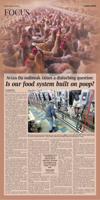So which type of tree reflects your holiday-style? Do you get a fresh cut, artificial or container-grown? Or do you just go out-of-town and let someone else do the decorating? All are certainly acceptable but there are different rules that apply to each. The news coming out of the live-cut Christmas tree industry is that there are no major shortages of trees and prices remain stable compared to the previous 5 years. Fraser firs are the most popular, most coming to Kentuckiana from North Carolina where the state has about 39,000 acres planted in Fraser firs destined for the Christmas tree market.
When choosing a fresh cut tree use your sense of smell and touch: fresh trees will be more fragrant, and the needles will be flexible yet firm. Certainly, consider the type of tree because the needles of a white pine will be softer than that of a Fraser fir. Also check the freshness by bouncing the butt of the trunk on the ground a couple of times to see how many needles actually fall from the tree. A few green and brown needles are normal.
If you are not quite ready to bring the tree in once you have purchased it then just get it in water and store it outside in the shade. The sooner you can get the trunk recut and in water the better…and in order to get your tree to drink you must have the stump end recut. The original cut sealed over shortly after the tree was cut so no water will be absorbed unless a fresh cut is made. Get the folks at the garden center to recut the end just before you leave and pop it into a pale of water as soon as you get home. Ideally our trees will drink about a quart of water a day when fresh.
Local u-cut operations are an option for live-cut trees, too. And this may be a really fun and safe way for the family to get outside and select the perfect tree. Check with your County Extension Service for local growers.
Live-cut trees are a renewable resource and one that you can reuse and recycle in the garden once you are finished. If you have beds of iris or daylilies, for example, cut the branches from the used tree and place them over the crowns of the plants to prevent them from heaving out of the ground due to freezing and thawing. Remove the branches in early spring before new growth begins. We will use cut branches in high traffic areas around pasture gates that get muddy in wet winter weather, so we don’t slip, too.
Purchasing a container=grown (or balled and burlapped) tree for the holidays is a popular tradition for many families but it takes some special care. A live evergreen is not well-suited to the indoor environment during the holidays. Our homes are typically dry and warm and if a live evergreen (intended to live outside) is in this environment too long it will break dormancy; the tree should stay in the house for about one week, tops. Keep your house as cool as you can and make sure that the root ball stays moist.
The logistics of having a live tree can be tricky. Root ball or containers can easily weigh 75 to 100 lbs. so moving the tree in and out of the house is no easy task. Keep the size as small as possible; preferably no taller than 6 feet. A smaller tree can be moved around more easily without damaging the root ball; we want to make sure that the root ball remains intact and doesn’t loosen or crumble under the weight of the tree. Most container-grown trees are easier!
Since planting will take place shortly after Christmas be prepared for the weather: consider digging your hole now and cover it with plastic so it is ready to go, and you can get the tree in the ground right after Christmas.






